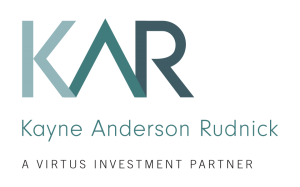
Julie Kutasov
Portfolio Manager and Senior Research Analyst
Kayne Anderson Rudnick
KAR Portfolio Manager Julie Kutasov reviews first quarter performance of the small- and mid-cap equity markets, top contributors and detractors in the KAR Small-Mid Cap Core strategy, and expectations for earnings growth in the current environment.
Listen Now
Transcript
BEN FALCONE: Hello, this is Ben Falcone, managing director with Kayne Anderson Rudnick, and with me today, I have Julie Kutasov, portfolio manager of the KAR Small-Mid Cap Core strategy. Welcome, Julie.
JULIE KUTASOV: Hello, Ben. Happy to be here.
BEN FALCONE: Julie, market returns were broadly positive again in the first quarter, even though many issues such as clarity on future Fed movements, geopolitical risk and an upcoming presidential election, even though heavily debated, still remain. Amidst the talk about the potential broadening out of returns within the market, the first quarter reverted right back to concentrated returns in the S&P leading with mid-caps a solid second and a few smaller AI related growth companies driving returns for the broader small-cap index. Can you provide our listeners with your perspective on markets for the start of 2024?
JULIE KUTASOV: Sure. U.S. stocks had a solid first quarter with the S&P 500® Index up over 10%, driven by a highly concentrated group of companies as you mentioned. Larger-cap names outperformed small caps and growth companies, many of these AI-driven as you noted, outperformed value counterparts. It was primarily an expectation of upcoming reductions in interest rates that drove equities’ performance during the quarter. Recall that the rally initially began in early November, driven by an improved inflation outlook and continued following the Fed's December meeting, when investors interpreted Chairman Powell's comments to mean that the Federal Reserve was ready to stop rate hikes and even cut and pivot from higher-for-longer expectations previously.
Inflation in the U.S. did in fact come down meaningfully as supply chains had normalized and as labor markets had cooled. And consumer spending, the key driver of the U.S. economy, held up well as easing inflation and strong wage growth boosted purchasing power. While improved, inflation remains elevated, however, and as recent CPI data suggests, may be more stubborn than anticipated. In addition, oil prices rose during the quarter, adding to inflationary pressures. As such, central bankers may potentially reduce the number of rate cuts or push them further into the future.
The first quarter's performance of the Russell 2500TM Index, the strategy’s benchmark, was driven by companies with weaker balance sheets and high volatility, an unfavorable environment for us as investors in high-quality companies. Despite these headwinds, the strategy outperformed the benchmark during the quarter primarily as we benefited from our underweight exposure to the underperform banking and real estate segments, as well as an overweight position in the outperforming industrials sector. We have a structurally low position in the banking and real estate segments due to their inherent capital intensity.
BEN FALCONE: Julie, can you discuss a few of the portfolio holdings that were key contributors and detractors to performance for the first quarter?
JULIE KUTASOV: Saia was our highest stock contributor for the quarter. Other top contributors were Interactive Brokers Group, W.R. Berkley Corp., LPL Financial, and Charles River Laboratories.
Saia is one of the largest transportation companies providing less-than-truckload or LTL services across North America. Shares performed strongly following the company's reports of better-than-expected operating results and positive outlook for shipment volumes and profitability improvement.
LTL freight is comprised of multiple customer shipments per whole and therefore requires a network of service centers, creating a significant skill advantage for larger players, and as supply chains become increasingly critical, shipping customers are acutely focused on reliable LTL providers. We believe that as Saia continues to provide high-quality service, the company should be able to raise prices, which would allow it to further expand its service center network and enhance the quality of service provided.
Ansys was our weakest performer of the quarter. Other detractors were Aspen Technology, Exponent, Teledyne Technologies, and Dolby Laboratories.
Ansys is a leading provider of engineering simulation software used in a wide range of industries, including aerospace and defense, automotive, energy, healthcare, electronics, and consumer goods. Ansys’s broad and deep portfolio, coupled with a vast installed user base, are hard to replicate. We believe it would also take time and effort for engineers to master new simulation tools as evidenced by the company's solid customer renewal rate. In mid-January, Ansys agreed to be acquired for $35 billion in cash and stock, so shares remained rangebound, trading near the offer price despite the company's reports of better-than-expected operating results.
BEN FALCONE: Julie, we know that longer-term earnings drive performance. Can you speak about this particular strategy and what you're seeing in terms of the current earnings growth as well as longer term expectations?
JULIE KUTASOV: We run a focused portfolio of high conviction, high-quality names while looking for solid business models and strong under-leveraged balance sheets, which are the result of the self-funding ability of these companies, certainly important in a high interest rate environment like the one we are facing today. Consistency is also very important to us, particularly as it relates to companies’ performance during challenging periods such as the Great Recession or the pandemic.
We spend a lot of time trying to understand what drives these companies’ earnings resilience and what makes the strong financial results sustainable into the future. The strategy's investment objective remains unchanged. Over an economic cycle, we strive to achieve returns that are meaningfully above those of the Russell 2500 benchmark but with low overall risk, and we believe the portfolio is well positioned to achieve this goal.
Holdings in the strategy have had return on equity, averaging over 24% over the past five years, nearly twice that of the Russell 2500 Index. Importantly, unlike the benchmark, these companies achieved these ROE’s with under-leveraged balance sheets. Over the past 10 years, the consistency of our companies’ earnings not only outpaced the Russell 2500 Index, but also the S&P 500. Even more importantly, capital generation, the source of future growth, also significantly exceeds that of the benchmark.
As the widely anticipated downturn failed to materialize recession, fears have given way to a soft landing outlook. History tells us, however, that it does take time for interest rate increases to ripple through the economy. In the past 11 Fed rate-hiking cycles, recessions typically started about two years after the central bank began raising rates. This cycle started in March 2022.
While we have been impressed and quite frankly surprised by the resilience of the U.S. economy, an economic slowdown remains a key risk in our view, particularly considering continuing inflationary pressures and growing tensions on the geopolitical front.
As I mentioned, inflation may prove to be more stubborn than expected, and there are concerns that it could surge again, mirroring the second wave that characterized the high inflation of the 1970’s. While the environment remains uncertain, we believe that our focus on high-quality companies, differentiated businesses, self-funding entities producing solid returns on capital from strong balance sheets is particularly relevant today.
BEN FALCONE: Julie, as always, thanks for taking the time to provide your insight to our KayneCast listeners.
JULIE KUTASOV: Thanks, Ben.
This information is being provided by Kayne Anderson Rudnick Investment Management, LLC (“KAR”) for illustrative purposes only. Information contained in this material is not intended by KAR to be interpreted as investment advice, a recommendation or solicitation to purchase securities, or a recommendation for a particular course of action and has not been updated since the date of the material, and KAR does not undertake to update the information presented should it change. This information is based on KAR’s opinions at the time of the recording of this material and are subject to change based on market activity. There is no guarantee that any forecasts made will come to pass. KAR makes no warranty as to the accuracy or reliability of the information contained herein.
Investing is subject to risk, including the risk of possible loss of principal.
Past performance is no guarantee of future results.
3539285
